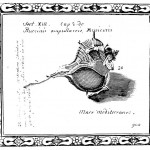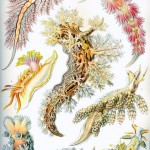Theres’s a great video, produced by Emilia-Romagna turismo, which lets you see some of the wide range of fish found in the Adriatic (one of the reasons you can eat so well in Rimini!).
The video, treasures of the adriatic, is – sadly – only in Italian (why, oh why don’t they go that little bit extra and record an english soundtrack as well???), but is well worth checking out in any case for the beautiful images of, amongst other things, sea horses (cavalucci), tub gunards (mazzola – there’s a local saying, for someone who is stubborn, that you have una testa come una mazzola – a head like a tub gunnard), cockles and muscles (cozze e vongole – delicious with pasta or simply on their own), and the adriatic squid (seppia).

a sea snail found in the adriatic, and once used - along the byzantine coast - for extracting imperial purple dye
Also featured is the sea-snail Murex brandaris, an impressive mollusc from which the ancients used to extract Tyrian Purple dye. In antiquity the Byzantine court restricted the use of the dye to Imperial garments – hence it’s being called ‘imperial purple’. The reason for its restriction was two-fold: firstly it was extremely expensive to produce, with each mollusc producing just a drop of dye. The second reason was that the dye produced a rich colour that, according to historians like Pliny, improved with age.

the nudibranco - a small 'sea slug'
Also the small, beautifully coloured Nudibranchia, commonly refered to, somewhat prosaically, as a sea slug. These tiny creatures are brightly coloured so that they can immediately be identified by passing fish, and avoided – as they are poisonous.
The video also moves farther out into the Adriatic, about 12 miles off the coast – showing dolphins at play, to the site of the Paguro marine protected area. This area is where, in September 1965, a platform for the extraction of methane gas from the Adriatic exploded, killing three workers, with a jet of water and gas that reached up to thirty metres into the air and burned for up to three months.
The remains of the structure have over time become an artificial reef, and a fascinating spot for divers to see the marine life of the adriatic. In the 1990s permission was given to add metal structures to the site underwater to extend the reef, and the whole area has become a protected zone where fishing is banned and diving is regulated.
A great video to watch, though hopefully they’ll produce an English language version shortly too!